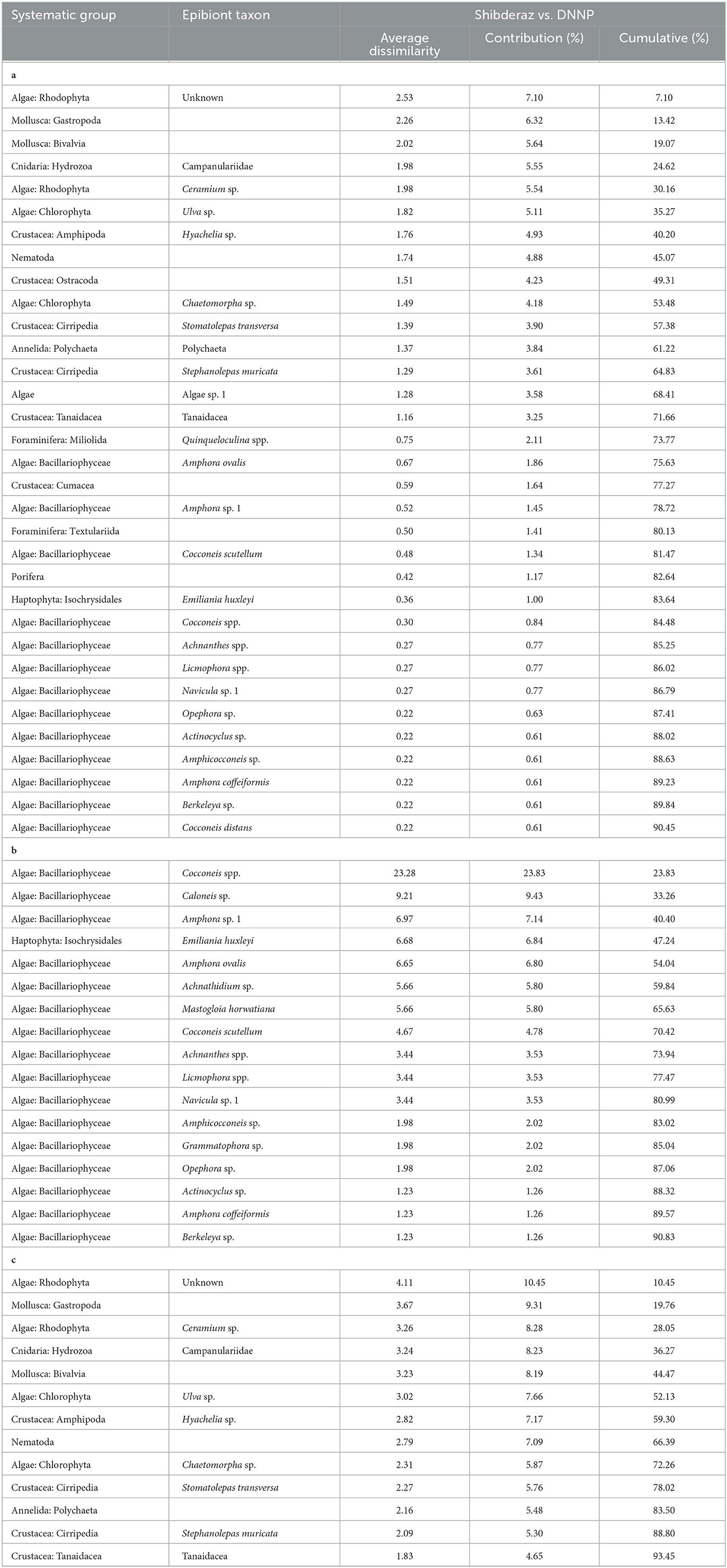- 1Department of Animal Sciences and Marine Biology, Faculty of Life Sciences and Biotechnology, Shahid Beheshti University, Tehran, Iran
- 2Qeshm Environmental Conservation Institute (QECI), Qeshm, Iran
A corrigendum on
Epibiont assemblages on nesting hawksbill turtles show site-specificity in the Persian Gulf
by Loghmannia, J., Nasrolahi, A., Rezaie-Atagholipour, M., and Kiabi, B. H. (2021). Front. Ecol. Evol. 9:690022. doi: 10.3389/fevo.2021.690022
In the published article, there was an error in the Conflict of interest as published. The corrected Conflict of interest appears below.
The handling editor SD and author AN declare a shared professional partnership at the time of review. This collaboration was ongoing during the review process.
The remaining authors declare that the research was conducted in the absence of any commercial or financial relationships that could be construed as a potential conflict of interest.
In the published article, there was an error in Figure 2 as published. In the caption, Part (j) of the caption should state “Nitzschia sp.” and not “Poulinea lepidochelicola.” The corrected Figure 2 caption appears below.
FIGURE 2. Examples of epibiont taxa recorded on the body surface of hawksbill sea turtles in the Iranian coasts of the Persian Gulf: (a) Chelonibia testudinaria on the carapace of hawksbill sea turtle; (b) specimens of Stephanolepas muricata; (c) Chelonibia testudinaria; (d) Platylepas hexastylos; (e) Tanaid; (f) Rotaliid foraminifer; (g) Chaetomorpha sp.; (h) Polysiphonia sp.; (i) Psammodictyon sp.; (j) Nitzschia sp.; (k) Tabularia sp.1; (l) Amphora sp.1
In the published article, there was an error in Table 3 as published. In the text of the table, the systematic group of the epibiont taxon “Emiliania huxleyi” was miswritten as Algae: Bacillariophyceae, whereas the correct name is Haptophyta: Isochrysidales. The corrected Table 3 and its caption appear below.

Table 3. Results of the SIMPER procedure to identify the relative contribution of each epibiont taxa to the dissimilarity between the epibiont assemblages of hawksbills (Eretmochelys imbricata) nesting on Shibderaz (Qeshm Island) and Dayyer-Nakhiloo National Park (DNNP; Bushehr) beaches, Iran: (a) all epibionts, (b) micro-epibionts, and (c) macro-epibionts.
In the published article, we neglected to explain whether all the various micro, meio, and macro epibionts were quantified or not. A correction has been made to Materials and methods, Statistical analysis, 2. This sentence previously stated:
“The analysis of epibiont structure was based on abundance data whereas species composition was evaluated based on presence-absence data.”
The corrected sentence appears below:
“Except for diatoms and other algal taxa, for which only presence-absence data were recorded, the analysis of epibiont structure was based on absolute abundance data. Species composition of the entire epibiont community (including micro, meio, and macro-epibionts) was evaluated based on presence-absence data.”
In the published article, we stated Emiliania huxleyi was a diatom species. A correction has been made to Results, 4. This previously stated:
“The SIMPER analysis revealed 97.68 and 39.37% dissimilarity between the two sites, respectively. Diatom species—including Cocconeis spp. (23.83%), Caloneis sp. (9.43%), Amphora sp. 1 (7.14%), Emiliania huxleyi (6.84%), and Amphora ovalis (6.80%)—contributed around 54% to the differences of the micro-epibionts (Table 3).”
The corrected sentence appears below:
“The SIMPER analysis revealed 97.68 and 39.37% dissimilarity between the two sites, respectively. Diatom species—including Cocconeis spp. (23.83%), Caloneis sp. (9.43%), Amphora sp. 1 (7.14%), and Amphora ovalis (6.80%)—contributed around 47% to the differences of the micro-epibionts (Table 3).”
In the published article, there was an error. Diatoms were the microepibionts focused on in this study and thus should not be described as dominating within this group. A correction has been made to Discussion, 5. This sentence previously stated:
“Our results revealed that while macro- and meio-epibiont taxa assemblages are relatively similar at both sites [...], micro-epibionts (26 taxa at Shibderaz and 6 taxa at DNNP, Table 1), dominated by diatoms, differ significantly”
The corrected sentence appears below:
“Our results revealed that while macro- and meio-epibiont taxa assemblages are relatively similar at both sites [...], micro-epibionts (26 taxa at Shibderaz and 6 taxa at DNNP, Table 1), represented mostly by diatoms, differ significantly”
The authors apologize for these errors and state that they do not change the scientific conclusions of the article in any way. The original article has been updated.
Publisher's note
All claims expressed in this article are solely those of the authors and do not necessarily represent those of their affiliated organizations, or those of the publisher, the editors and the reviewers. Any product that may be evaluated in this article, or claim that may be made by its manufacturer, is not guaranteed or endorsed by the publisher.
Keywords: barnacles, epibionts, environmental extremes, Strait of Hormuz, sea turtles
Citation: Loghmannia J, Nasrolahi A, Rezaie-Atagholipour M and Kiabi BH (2023) Corrigendum: Epibiont assemblages on nesting hawksbill turtles show site-specificity in the Persian Gulf. Front. Ecol. Evol. 11:1191544. doi: 10.3389/fevo.2023.1191544
Received: 22 March 2023; Accepted: 17 April 2023;
Published: 17 May 2023.
Edited and reviewed by: Sergey Dobretsov, Sultan Qaboos University, Oman
Copyright © 2023 Loghmannia, Nasrolahi, Rezaie-Atagholipour and Kiabi. This is an open-access article distributed under the terms of the Creative Commons Attribution License (CC BY). The use, distribution or reproduction in other forums is permitted, provided the original author(s) and the copyright owner(s) are credited and that the original publication in this journal is cited, in accordance with accepted academic practice. No use, distribution or reproduction is permitted which does not comply with these terms.
*Correspondence: Ali Nasrolahi, YV9uYXNyb2xhaGlAc2J1LmFjLmly
 Javad Loghmannia
Javad Loghmannia Ali Nasrolahi
Ali Nasrolahi Mohsen Rezaie-Atagholipour
Mohsen Rezaie-Atagholipour Bahram H. Kiabi1
Bahram H. Kiabi1